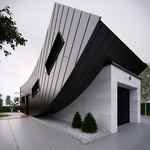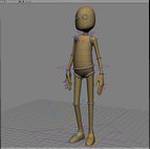Hi guys, im in the middle of a bottle neck at work. im looking around with not much luck for a compund that allows me to make wakes on a pond, like maya woudl do (with the pond simulation object) or max would do with reactor. Does anybody know of an ice compund that allows me to do that and controll easily the spread of the wake, the speed, and to put deflectors in. Im working out so far with this scene i found by Andreas Felix Gebhardt on his website
http://vimeo.com/1656114 but my ice knowledge is not as sharp as i would like to. Checking out the parameters and getting my hands dirty hasnt work really good for me to control the parametters i need, and i cant put deflectors on his solution ( in this case the deflector would be the boundary of the geometry, which really is not much of a problem if i model the water surface as i need to) but i really cant control the speed of the spread or the size of the wake or decay.... Does anybody know of a compound laying around or any solution tha allows me to do this in XSI ?
Moderator edit: please use the URL tags - HB
wake pond effect
Plugins linking to this thread: (hide)
 Wake Pond effect
Wake Pond effect Per request in this si-community thread, user Matic posted this wave ripples effect using an ICE verlet/spring
simulation as a quicker alternative to other water simulations.
Yeah the problem is that these ripple compounds (like one I did a while back and a few others have made) they tend to use a spring-based approach which isn't a true simulation of water per se, but rather a simple spring network with some force propagation thrown in... you can get good results, but if you are looking for some of the fine details of behavior you would get in real life you need to go to a much more complex simulation. And right now for softimage that would mean maelstrom (proprietary) or a sph-like solver like lagoa. Realflow/realwave might be a good solution if you are willing to go outside softimage.
But if the spring-based solvers are close, you might be able to do some cheats and get them to do what you need. Here's the one I built... It's about as simple an approach as I could make, I slammed it together in a couple of hours to meet a sudden need in green lantern (we were developing the look for the scene where a woman gets whisked away by a flood of green-energy »water.«) So no promises on whether it will help or not, but it's at least simple enough you can hack at it. I hope it helps a bit.
local backup: wakePond.zip
Yeah the problem is that these ripple compounds (like one I did a while back and a few others have made) they tend to use a spring-based approach which isn't a true simulation of water per se, but rather a simple spring network with some force propagation thrown in... you can get good results, but if you are looking for some of the fine details of behavior you would get in real life you need to go to a much more complex simulation. And right now for softimage that would mean maelstrom (proprietary) or a sph-like solver like lagoa. Realflow/realwave might be a good solution if you are willing to go outside softimage.
But if the spring-based solvers are close, you might be able to do some cheats and get them to do what you need. Here's the one I built... It's about as simple an approach as I could make, I slammed it together in a couple of hours to meet a sudden need in green lantern (we were developing the look for the scene where a woman gets whisked away by a flood of green-energy »water.«) So no promises on whether it will help or not, but it's at least simple enough you can hack at it. I hope it helps a bit.
local backup: wakePond.zip
author site: author link: http://andy.moonbase.net / source: si-community thread
- Hirazi Blue
- Administrator
- Posts: 5107
- Joined: 04 Jun 2009, 12:15
Re: wake pond effect
I am not 100% sure, but over at the Area there is a downloadable animatable ripple compound.
I haven't tried it myself, though.
Mind you: this is not intended as the solution (which it quite probably isn't),
but might work as the basis of a solution... ;)
I haven't tried it myself, though.
Mind you: this is not intended as the solution (which it quite probably isn't),
but might work as the basis of a solution... ;)
Stay safe, sane & healthy!
Re: wake pond effect
The thing is the behavior of that compound is not accurate enough for what i need. arrg.. trying other stuff but struggling a bit...
Re: wake pond effect
Yeah the problem is that these ripple compounds (like one I did a while back and a few others have made) they tend to use a spring-based approach which isn't a true simulation of water per se, but rather a simple spring network with some force propagation thrown in... you can get good results, but if you are looking for some of the fine details of behavior you would get in real life you need to go to a much more complex simulation.
And right now for softimage that would mean maelstrom (proprietary) or a sph-like solver like lagoa. Realflow/realwave might be a good solution if you are willing to go outside softimage.
But if the spring-based solvers are close, you might be able to do some cheats and get them to do what you need. Here's the one I built... It's about as simple an approach as I could make, I slammed it together in a couple of hours to meet a sudden need in green lantern (we were developing the look for the scene where a woman gets whisked away by a flood of green-energy "water.") So no promises on whether it will help or not, but it's at least simple enough you can hack at it. I hope it helps a bit.

And right now for softimage that would mean maelstrom (proprietary) or a sph-like solver like lagoa. Realflow/realwave might be a good solution if you are willing to go outside softimage.
But if the spring-based solvers are close, you might be able to do some cheats and get them to do what you need. Here's the one I built... It's about as simple an approach as I could make, I slammed it together in a couple of hours to meet a sudden need in green lantern (we were developing the look for the scene where a woman gets whisked away by a flood of green-energy "water.") So no promises on whether it will help or not, but it's at least simple enough you can hack at it. I hope it helps a bit.

- Attachments
-
- verletSpringWater_testScene_v002.zip
- example scene, verlet spring water ripples
- (147.74 KiB) Downloaded 870 times
-
 Init Verlet Deformation.xsicompound
Init Verlet Deformation.xsicompound- Verlet spring water compound init
- (27.19 KiB) Downloaded 612 times
-
 BasicVerletSpringDeformation.1.3.xsicompound
BasicVerletSpringDeformation.1.3.xsicompound- Verlet spring water compound
- (80.12 KiB) Downloaded 648 times
Re: wake pond effect
Thank you very much!! ill look right into it! i owe you a beer!!
Re: wake pond effect
Matic wrote:Yeah the problem is that these ripple compounds (like one I did a while back and a few others have made) they tend to use a spring-based approach which isn't a true simulation of water per se, but rather a simple spring network with some force propagation thrown in... you can get good results, but if you are looking for some of the fine details of behavior you would get in real life you need to go to a much more complex simulation.
And right now for softimage that would mean maelstrom (proprietary) or a sph-like solver like lagoa. Realflow/realwave might be a good solution if you are willing to go outside softimage.
But if the spring-based solvers are close, you might be able to do some cheats and get them to do what you need. Here's the one I built... It's about as simple an approach as I could make, I slammed it together in a couple of hours to meet a sudden need in green lantern (we were developing the look for the scene where a woman gets whisked away by a flood of green-energy "water.") So no promises on whether it will help or not, but it's at least simple enough you can hack at it. I hope it helps a bit.
I am also looking for something like this and thanks a lot for the share Matic, very kind of you.
I am definitely not able to really make out to much of the compounds, starting to think it is way to complicated for me bu love ICE.
Is this compound able to create very thing ripples, like water that is vibrating from sound or subtle earth quake? And also so that the edges of the ripple bounce of lets say the walls (or the edges of the hole the water gathered in).
Any direction in the right way would be much appreciated.
Many thanks in any case.
Re: wake pond effect
Keep pushing yourself to make sense of ICE compounds, you'll get the hang of it after a while.cnever wrote: I am also looking for something like this and thanks a lot for the share Matic, very kind of you.
I am definitely not able to really make out to much of the compounds, starting to think it is way to complicated for me bu love ICE.
Is this compound able to create very thing ripples, like water that is vibrating from sound or subtle earth quake? And also so that the edges of the ripple bounce of lets say the walls (or the edges of the hole the water gathered in).
Any direction in the right way would be much appreciated.
Many thanks in any case.
This compound is exactly right for something like vibration-ripples in a glass or puddle. Make a very dense mesh, set up the compounds, and tap the surface lightly with an invisible collision object.
Bouncing off the edges, honestly I don't remember if it would. I think the edges of the mesh will show some bouncing... really all that is happening here is each point on the mesh is bound to it's starting position by a spring, and some of the energy in each spring is shared with the point's neighbors.
If you push one point, it wobbles, and it's neighbors then wobble, and so on. A very primitive kind of water sim. If you were to put a collision object next to one of the points of the mesh and it was to wobble into the collider, it would bounce off - and that bounce energy would propagate outwards too...
The way to think about it is as a bunch of points-on-springs, not as "water." You are creating an illusion of water, this kind of approach is very fast but very simple, so you won't get subtle effects usually. Although if you push a sphere through the water surface, you do see a classic sort of "droplet" effect like in the picture, and simple wakes can be made as well as surface jiggling etc.
You can also use this compound as a sort of fast, simple soft body, for jiggle of clothes, skin etc. But in the end, it's just points-on-springs. ;)
Who is online
Users browsing this forum: No registered users and 78 guests

































































